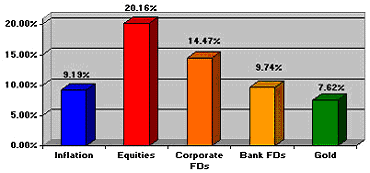|
Traditionally debt instruments are known for generating a predetermined income for a given period of time, other than in cases of default. Hence they are also known as fixed income instruments. Some examples include:
• NBFC Deposits
• Company Deposits
• Bonds
• Debentures
• Bank Deposits (FDs and savings accounts)
• Government Small Savings Schemes (E.g. PPF)
The introduction of Floating Rate securities moves away from the concept of receiving a fixed rate of interest but suggests a variable rate of interest based on an underlying factor such as London Interbank Offer Rate (“LIBOR”) or Mumbai Interbank Offer Rate (“MIBOR”). An example of such a security is a Floating Rate Bond whose interest rate is MIBOR plus 50 basis points, where MIBOR is variable. A preference share is a hybrid instrument, which can be categorized as a fixed income instrument since the investors receive a fixed dividend before the regular equity holders receive their dividend.
Is a share in the ownership of a company’s assets and earnings. Companies usually issue equity when they require addition capital to fund their existing business or expand. At this point of time the company sells part of the ownership of the company to the public. Listed equities are generally highly liquid since they are traded in the stock exchange.
An investor makes money from equity through dividends paid out by the company (from its profits) on a periodic basis as well as capital appreciation as reflected in the stock price, which fluctuates in the market. Hence an investors returns are directly related to the performance of the company’s business. Equities do not offer any assured returns, but historically promise the highest return in the long run, as depicted by the graph below.
Investment Returns (CAGR 1980 – 1998)

These are the short-term version of debt instruments, which typically have a maturity of less than one year. Yields are slightly above that of the savings account rate in the Banks. These usually tend to preserve the investor’s initial investment and are usually the least risky asset class from the four described here.
|


